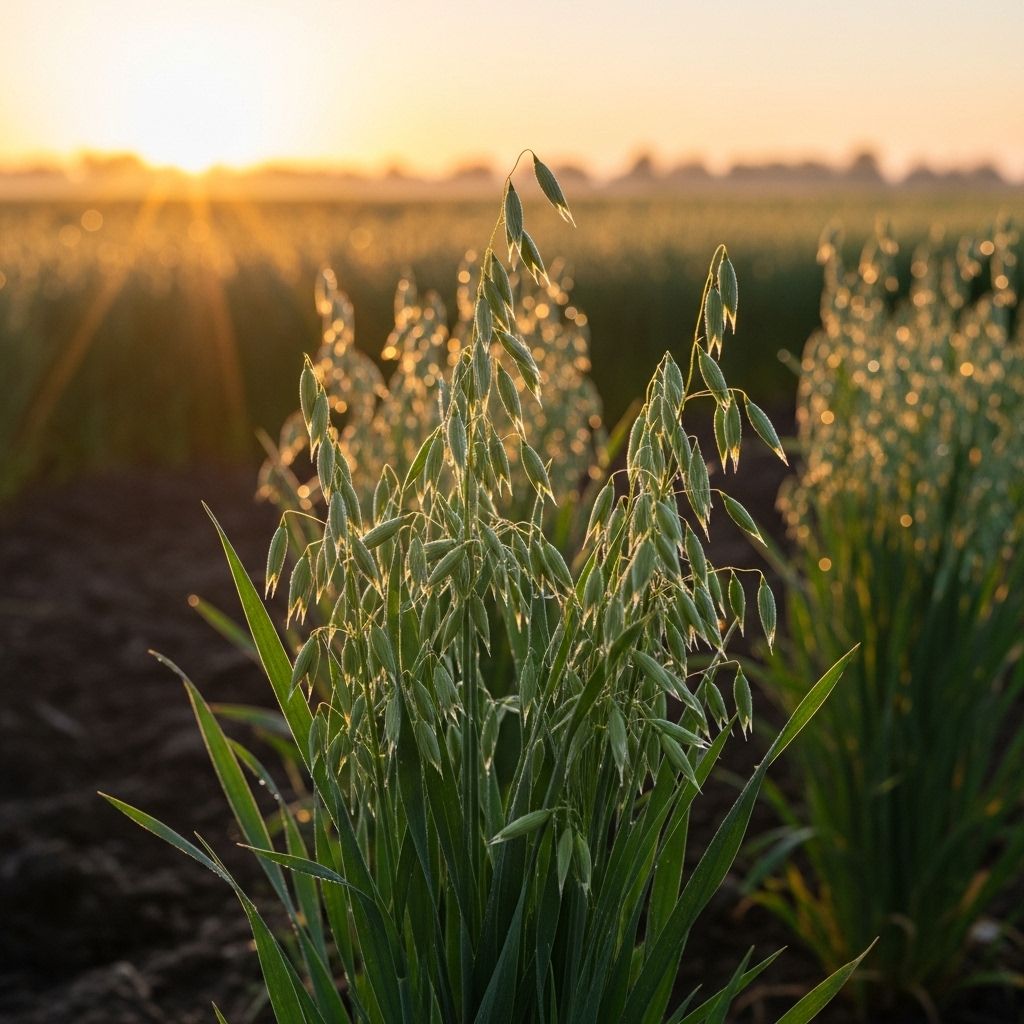How to Grow Oats: Detailed Guide for Planting, Care, and Harvesting
Cultivate flourishing grains that boost soil vitality and offer wholesome rewards.

Image: HearthJunction Design Team
How to Grow Oats: Complete Guide for Home Gardeners
Oats (Avena sativa) are a rewarding, versatile grain crop for the home garden. Whether you want to harvest nutrient-rich seeds for breakfast or use oats as a hearty cover crop to improve your soil, this guide covers everything you need to know to successfully plant, grow, and harvest oats in your own backyard.
Why Grow Oats?
Oats are packed with nutrients, provide a reliable ground cover, and thrive in cooler climates where other grains may struggle. Growing your own oats allows you to enjoy freshly harvested grains and can significantly boost the quality and health of your soil by reducing erosion and adding organic matter.
- Nutritious grain: High in dietary fiber, protein, and essential minerals.
- Easy to grow: Tolerant of a wide range of soil types and conditions.
- Beneficial cover crop: Prevents soil erosion, suppresses weeds, and improves soil structure.
- Cool-weather friendly: Performs best in spring and fall gardens.
Getting Started: Choosing Oat Varieties
There are several types of oats, but most home gardeners grow common oats (Avena sativa) or hull-less oats for easier post-harvest processing. Choose a variety suited to your growing region and intended use. For example, hull-less types are best if you want to eat the grains, while traditional hulled oats work well for cover cropping.
When to Plant Oats
Timing depends on your goal and local climate:
- For grain harvest: Sow oats in early spring as soon as the soil can be worked, or in fall for an overwintering crop and summer harvest.
- For ground cover: Plant mid-summer to establish strong growth before winter. In colder regions, the crop often winterkills, forming a natural mulch.
Key Planting Windows
| Purpose | Planting Time | Harvest |
|---|---|---|
| Food grain | Early spring or late fall | Early fall or summer |
| Cover crop | Mid to late summer | Winterkilled or mowed in spring |
Where to Plant Oats
Oats perform best in locations with full sun and well-draining soil. They tolerate a wide range of soils but avoid waterlogged or extremely dry areas for best results.
Soil Preparation
Oats thrive in soils with these characteristics:
- Soil type: Average to moderately rich, well-draining soil.
- Soil pH: Slightly acidic to neutral; optimal range is 4.5 – 6.
- Amendments: Typically, oats require little extra fertilization, especially if grown with nitrogen-fixing crops like peas or vetch.
Before planting, rake the bed to loosen the top 2–3 inches of soil. Remove stones and large clods. If desired, add compost or well-rotted manure to improve fertility and soil texture.
How to Plant Oats
- Broadcast the seeds: Scatter seeds at a rate of about two seeds per square inch for in-ground planting. Precision is less important than with many other crops, as oats are tolerant of crowding.
- Cover the seeds: Lightly rake or gently press the seeds into the top 1–2 inches of soil to aid germination and hide them from birds.
- Water thoroughly: Keep the soil evenly moist, especially during germination. Oat seeds germinate best when soil temperatures are at least 40°F (4°C), but will sprout more quickly as temperatures rise.
Row and Plant Spacing
- Single plants: Minimum 3 inches apart in all directions; 3-inch row spacing is also suitable.
- With other cover crops: Increase spacing to about 8 inches to reduce competition.
Oat Care and Maintenance
- Watering: Oats require consistent moisture, especially during the early growth stages and in hot weather. Deep, infrequent watering encourages robust root systems.
- Weeding: Oats grow quickly and, when densely sown, shade out most weeds. However, remove any persistent weeds early to reduce competition.
- Feeding: Extra feeding is rarely necessary. If you have poor soil, a top dressing of compost or balanced organic fertilizer can help at planting time.
- Temperature: Oats flourish in cool weather and tolerate light frosts but will be damaged by temperatures below 5°F (-15°C). When temperatures soar, provide supplemental water.
Growing Tips
- Companion planting: Oats do well with peas, vetch, or other nitrogen-fixing plants as a mixed cover crop.
- Succession planting: Stagger plantings for ongoing harvest and soil cover.
- Mulching: Letting winterkilled oats decompose in place adds valuable organic matter to the garden.
Managing Pests and Diseases
Oats are generally trouble-free but can occasionally be affected by common pests and diseases:
- Aphids: Watch for infestations, especially in warm, humid weather. Use a strong jet of water or insecticidal soap if numbers are high.
- Slugs and snails: Especially in cool, damp conditions. Handpick or use organic slug baits if needed.
- Fungal diseases: Minimize by rotating crops and avoiding persistent soil moisture.
Harvesting Oats
For most home gardeners, harvesting oats is a simple, hands-on process:
- Time to harvest: 80–100 days after planting, oat seedheads will begin to mature. The right time is when the grains are firm but still show a slight green tinge.
- Method: Cut oat stalks with a sharp sickle or shears just below the grain heads. Bundle stalks together into small sheaves and stand them upright in a dry, airy spot to cure for about two weeks.
- Threshing: Once dry, rub or beat the heads to separate the grains from the stalks and chaff. Winnowing by blowing gently can help remove remaining chaff.
Post-Harvest Processing
For hull-less oats, simply clean and store the grains. For hulled varieties, further processing may be needed to remove the tough outer hulls before use in the kitchen.
Storing Oats
- Airtight containers: Store in jars, buckets, or sealed bags in a cool, dry place to prevent moisture and pests.
- Freezing: For longer-term storage, oats can be frozen to kill any potential insect eggs.
Oats as a Cover Crop
Beyond grain production, oats excel as a cover crop. Their dense roots prevent erosion, loosen soil, and suppress weeds. In cold climates, oats sown in late summer or early fall typically winterkill, forming their own mulch layer that protects soil and decomposes by spring. In milder zones, mow or turn under in late spring before seedheads form to prevent volunteer oat plants next season.
Frequently Asked Questions (FAQs)
Q: When is the best time to plant oats?
A: For grain, plant oats in early spring or late fall. For a cover crop, plant mid to late summer so they grow vigorously before winter sets in.
Q: Can I grow oats in containers?
A: While possible, oats perform best in the ground or large raised beds due to their spreading nature and tall growth.
Q: How do I harvest and thresh my oats?
A: Cut mature stalks, bundle, and cure for two weeks. Once dry, rub the seedheads to separate grain from chaff and winnow to clean.
Q: Are oats susceptible to many pests?
A: Oats are relatively pest-free but can occasionally host aphids, slugs, or snails, especially in humid conditions. Monitor regularly and treat as needed.
Q: What varieties are best for home gardens?
A: Hull-less oats are easiest to process for food. Traditional oat varieties work well for animal fodder or as a cover crop.
Conclusion
Growing oats is a rewarding addition to the home garden, providing nutritious grain and vital organic matter for healthy soil. With minimal inputs and straightforward care, even beginner gardeners can enjoy a successful oat harvest. Follow these tips for planting, maintenance, and harvest, and enjoy the satisfaction of homegrown oats from your own backyard.
References
Read full bio of Srija Burman












